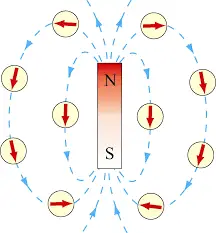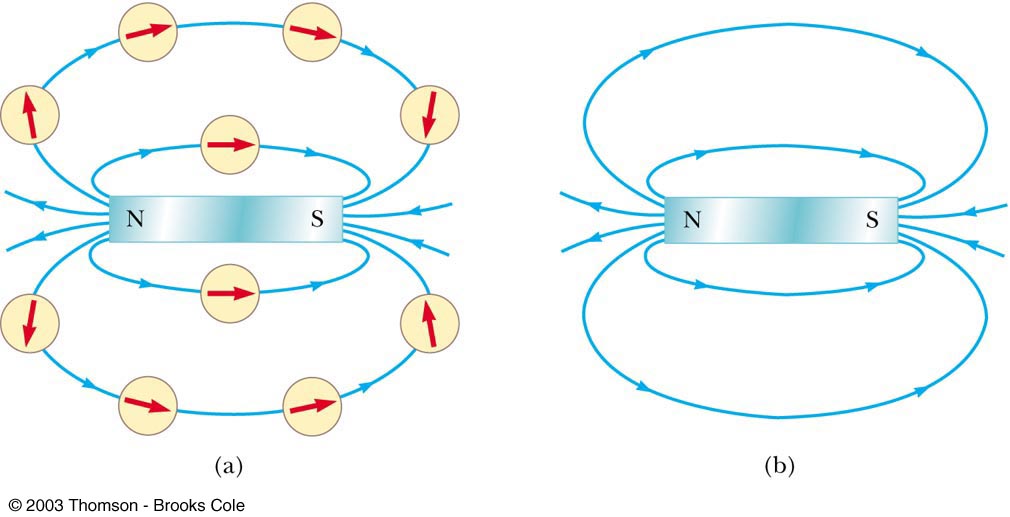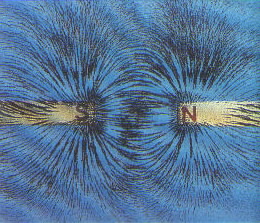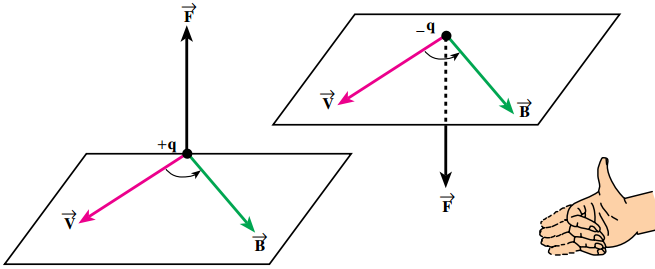Magnetic field : Definition and Solved Examples
You are familiar with the concept of an electric field. In that topic, you noticed that the surrounding space of any charged particle is formed a property that can exert a force upon a test charged particle.
To describe that property the notion of the electric field $\vec E$, which is a vector quantity, is introduced. There is also a mysterious property in the space around a magnet that can induce magnetic property in the unmagnetized iron objects and attract or repel other magnets.
For example, when one of the poles of a bar magnet moves to the vicinity of a compass needle that is aligned in the north-south direction, the needle starts to turn.
In this situation, if the magnet is removed, the needle again points to the original direction that was north-south.
This experiment shows that there is a property around the space of a magnet. This property that can exert a force on a tiny compass needle is called the magnetic field and is denoted by $\vec B$.
The magnetic field can be created by a magnet or produced by moving a charged particle or current in a wire. In this section, we will not concentrate on the creation of a magnetic field. Here we will describe the interaction of a moving charge with an external magnetic field.
The magnetic field is a vector quantity in physics, as the electric field, so analogous to any vector quantity it has a magnitude and direction. In the following, we first deal with its direction and then define the magnitude and its unit.
To have a better understanding of the properties of vectors, refer to the following page:
Vector, definitions, formula, and solved problems
The direction of the magnetic field:
We have probably seen that when a compass needle is placed near a magnet, the needle turns and points in a particular direction.

If the magnet is aligned in another direction, the compass will also turn and point in another direction.
Magnetic field, by definition, at any position is along the compass needle and its direction is defined as from south pole to north pole.
In other words, the direction of the magnetic field $\vec B$ at any point in space shows the direction of the north pole of a compass needle at that point.
Magnetic field lines:
An electric field is shown by electric field lines. Just as an electric field, we can also picture (imagine) magnetic fields by magnetic field lines.
These lines are drawn so that each point direction of the magnetic field is tangent to the field line at that point which can be traced by a needle compass as shown in the figure below.
The field line at any position is parallel to the magnetic field at that point. The density of lines at any point of space represents the strength of the magnetic field at that point.
Another important note is that since the direction of $\vec B$ at each point is unique, the field lines never intersect one another.
In the following figure, the magnetic field lines of a permanent bar magnet are shown. These lines, in general, are outside the magnet and point away from the $N$ pole and toward the $S$ pole. Inside the magnet, the lines pass through the $S$ pole to the $N$ poles, which are in the opposite direction of outside the magnet.

Magnetic field patterns can be shown by iron filings sprinkled on the paper near a magnet, as shown in the figure for various configurations of the poles.


Important note: unlike the electric charges, strong evidence shows that there are no isolated magnetic poles in nature. In other words, magnetic poles always come in pairs and can’t be isolated.
For example, breaking a bar magnet leads to two complete bar magnets even if you continue this breaking down to the atomic scale.
Magnetic force:
The existence of a magnetic field at a particular point in space can be quantified, similar to the electric field’s definition, by measuring the magnetic force $\vec {F}_B$ exerted on a specific test particle at that point.
But this situation is totally different from the electric force counterpart since experiments show that the magnetic force is proportional to the velocity $\vec v$ of the test particle, unlike the electric force which can be exerted on a rest-charged particle.
In the next section, we explain the additional complexity that appears in the magnetic forces.
Another way to quantify the magnetic field is to measure the magnetic force on a wire carrying current. With the aid of these two measurements, one can define the magnetic field at each point in space.
Force on a moving charged particle in a magnetic field:
Experimentally can be shown that when a charged particle $q$ with velocity $\vec v$ moves through a magnetic field $\vec B$ (so that its direction of motion does not parallel to the field), it experiences a force which is, as shown in the figure, perpendicular to the directions of both $\vec v$ and $\vec B$. This force is called the magnetic force.
Experiments show that the magnitude of the force acting on a moving charged particle in a magnetic field $\vec B$ depends on the following factors:
- Electric charge ($q$) : the larger the electric charge $q$, the more magnetic force acting on it. i.e. $F \propto q$.
- The velocity of moving charge ($\vec v$): the more the velocity, the greater the magnetic force acting on it i.e. $F\propto v$.
- Magnetic field ($\vec B$): the larger the magnetic field, the more force acting on the charge i.e. $F\propto B$.
- The angle between the magnetic field and velocity vector $\vec v$: the magnetic force on a moving charged particle is proportional to $\sin \theta$ i.e. $F\propto \sin\theta$.
These experimental results can be summarized in a single equation as follows \[F=qvB\, \sin\theta \]
Therefore, in the SI units, the formula of the magnetic force on a charged moving particle may be rewritten, in vector form, like \[\vec F=q\vec v \times \vec B\]
The direction of the force acting on a moving charge:
The direction of the magnetic force acting on a positively charged particle with velocity $\vec v$ through the magnetic field $\vec B$ is determined by the right-hand rule as follows.
Point fingers of your right hand along the direction of velocity $\vec v$. Curl them toward the magnetic field $\vec B$ through the smaller angle. Your extended thumb points in direction of magnetic force or $\vec v\times\vec B$.
Force on a negative charge is in the opposite direction of the force on a positive charge (since the vector product is anti-commutative that is $\vec A\times\vec B=-\vec B\times \vec A$).
The alternative rule for finding the direction of $\vec v\times\vec B$: point your fingers of the right hand in direction of $\vec{B}$ and the thumb in the direction of $\vec{v}$. The palm shows the outward direction of the magnetic force $\vec F_B$ on a positive charge. The force on a negative charge is in the opposite direction.

The equation above defines the magnetic field $\vec B$ in terms of the force exerted on a moving charged particle. The SI unit of magnetic field magnitude is the tesla ($T$).
In simple words, when a particle of charge $1\, \rm C$ moves with velocity $1\, \rm {m/s}$ perpendicular to a magnetic field of $1\,\rm T$ it experiences a force of one newton: \[\rm {1\, T}=1\, \rm{\frac{N}{C.m/s}}\]
By definition of electric current so a coulomb per second is one ampere, we have \[\rm {1\,T}=1\,\rm{\frac{N}{A.m}}\]
Like coulomb, the SI unit of electric charge, the tesla is a very large unit of magnetic field strength.
In practice, the magnitude of the magnetic field presents in everyday life ranging from some millitesla to one or two teslas.
The magnetic field magnitude of powerful permanent magnets is about $0.1\,\rm T$ to $0.5\,\rm T$.
The Earth’s magnetic field is of the order of $10^{-4}\,\rm T$ or industrial or laboratory magnets have strengths of the order of $1\,\rm T$, or $2\,\rm T$.
Because of this another unit for $B$, the gauss, is used which is related to the SI unit tesla as \[\rm {1\, G=10^{-4}\, T}\]
Remember that the gauss is not an SI unit so you must convert it to tesla when making calculations.
Equation $\vec F=q\vec v\times \vec B$ shows that when a particle moves parallel($\theta=0$) or antiparallel ($\theta =\pi$) through a magnetic field, there is no force on it. But if it moves perpendicular ($\theta=\pi/2$) to the field it experiences a maximum force $qvB$.
Now, we use the above formula to solve some magnetic field problems for more understanding.
Magnetic Field Example Problems
Example (1): a charged particle of $q=4\,\rm {\mu C}$ moves through a uniform magnetic field of $B=100\,\rm G$ with velocity $2\times 10^{3}\,\rm {m/s}$. The angle between $\vec B$ and $\vec v$ is $30{}^\circ$. Find the magnitude of the force acting on the charge.
Solution: the magnitude of the magnetic force acting on a moving charged particle is found by the formula below \begin{align*} |\vec F|&=|q|vB\, \sin \theta\\ &=(4\times 10^{-4})\times (2\times 10^{3})\times 10^{-2}\,\sin 30{}^\circ\\ &=4\times 10^{-5}\, \rm N \end{align*}
Example (2): The magnetic field $B=0.5\hat i$ is acting on proton moving in $xy$ plane with velocity $\vec v=10^5 \hat i+10^5 \hat j\,(\rm {m/s})$. Find the force acting on the proton.
Solution:
From the equation $\vec F=q\vec v\times \vec B$ the direction of the force on the particle is \begin{align*} \vec F&=\left(1.6\times 10^{-19}\right)\left(10^{5}\hat i+10^{5}\hat j\right)\times \left(0.5\hat i\right)\\ &=8\times 10^{-15}\left(\left(\hat i \times \hat j\right)+\left(\hat j \times \hat i\right)\right)\\ &=8\times 10^{-15}\, \rm {N} \left(-\hat k\right) \end{align*} Therefore, the magnetic force is in the negative $z$ direction.
Example (3): at the moment that the velocity vector of an electron of charge $e=-1.6\times 10^{-19}\,\rm {C}$ in the magnetic field $\vec B=5\times 10^{-4}\,\hat k\, \rm T$ is $\vec v=2\times 10^{7}\,\left(\hat i+\hat j\right)\,\rm {m/s}$ find the magnetic force on the electron?
Solution:
The magnetic force on a positive charge is given by the following formula \begin{align*} \vec F&=q\vec v\times \vec B\\ &=\left(-1.6\times 10^{-19}\right)\left| \begin{array}{ccc} \hat i & \hat j & \hat k\\ 2\times10^{7} & 2\times 10^{7} & 0\\0 & 0 & 5\times 10^{-4} \end{array} \right|\\ &=-1.6\times 10^{-15}\,\left(\hat i-\hat j\right)\, \rm N \end{align*} The magnitude of the magnetic force is the square root of sum of its components as\begin{align*} \vec F_B&=1.6\times 10^{-15}\sqrt{1^2+(-1)^2}\\ &=1.6\times 10^{-15}\times \sqrt 2\\ &=2.3\times 10^{-15}\,\rm N \end{align*}
Example (4): A proton (mass = $1.66\times 10^{-27}\,\rm {kg}$) is circulating in the plane of the page due to a magnetic field perpendicular to the page and directed into it. The radius of its circulating motion is $\rm {9\,cm}$ and its speed is $\rm {1.6\,km/s}$. Find the value of the magnetic field and the direction of the motion.
Solution:
When a particle moves in a circular motion it experiences a centripetal force that in this case is provided by the magnetic force acting on the particle. Using Newton’s second law for circular motions we have \[\Sigma \vec F_r=m\vec a_r=\frac{mv^2}r \left(-\hat r\right)\] Where $\hat r$ is the unit vector along the radius and toward the center of the circle and $r$ is the radius of the circle. Since the magnetic force must be toward the center and the angle between $\vec B$ and $\vec v$ is $\theta=90{}^\circ$, we have \begin{align*} qvB&=\frac{mv^2}{r}\\ \Rightarrow B&=\frac{mv}{qr}\\ &=\frac{\left(1.6\times 10^{-27}\,\rm {kg}\right)\left(1.6\times 10^{3}\,\rm {m/s}\right)}{\left(1.6\times 10^{-19}\,\rm{C}\right)\left(9\times 10^{-2}\,\rm m\right)}\\&=0.185\times 10^{-3}\,\rm {mT} \end{align*} Using the right-hand rule, get the direction of velocity around the circle as follow: Put fingers of your right hand in a counterclockwise direction along the circle and curl them into the page, the thumb points in the radial direction, which is indeed the direction of the magnetic force. Thus, the proton circles counterclockwise around the path.
There is a nice page about unit vectors, refer to it to understand more
Unit vectors: definition, formula, and solved examples
The motion of a charged particle in electric and magnetic fields:
If a charged particle is placed in a region of space containing both electric and magnetic fields two forces, magnetic and electric, act on it which is called Lorentz force and is given by \[\vec F=q\left(\vec E+\vec v \times \vec B\right)\]
Since the magnetic force is always perpendicular to velocity $\vec v$, so it cannot change the magnitude of the velocity but only its direction. Therefore, in the motion of a charged particle in the presence of electric and magnetic fields, only the electric field does work on the particle.
Example (5): show that the kinetic energy of a particle in a magnetic field is constant.
Solution: being constant of a quantity means that its time rate is zero. The time rate of change of energy is called power $P$. Recall that power of a particle with velocity $\vec v$ under the action of force $\vec F$ is given by $P=\vec F \cdot \vec v$. by combining these we obtain \begin{gather*} \frac{dK}{dt}=P=\vec F_B \cdot \vec v\\ \Rightarrow \frac{dK}{dt}=q\left(\vec v\times \vec B\right)\cdot \vec v=0\Rightarrow K=constant \end{gather*}In the last step, we have used the fact that $\vec v \times \vec B$ is a vector perpendicular to $\vec v$ thus the dot product of this vector and $\vec v$ is zero since the angle between them is $90^\circ$.
Example (6): there is a uniform magnetic field $\vec B$ into the plane of the page. If a particle of charge $q$ and mass $m$enters this region perpendicular to the magnetic field $\vec B$, what is the path of the motion?
Solution:
At the moment that the particle enters the field a perpendicular force acts on it at this moment the particle in response to the magnetic force changes the direction of its velocity but we know that the magnetic force remains always perpendicular to the velocity. Recall from the section of circular motion questions, that when the force is always perpendicular to the velocity, the path of the particle is a circle. This magnetic force serves as a centripetal force toward the center of the circle, so using Newton’s second law we can obtain the radius of the circle as follows \begin{gather*} F_r=ma_r=\frac{mv^{2}}r\\ \Rightarrow qvB=\frac{mv^{2}}{r} \quad \Rightarrow \quad r=\frac{mv}{qB} \end{gather*} The period of the motion is equal to the circumference of the circle divided by the speed of the particle \[T=\frac{2\pi r}{v}=\frac{2\pi m}{qB}\] The angular speed of the motion, which is called the cyclotron frequency since charged particles circulate in a special type of accelerator called cyclotron at this frequency, is obtained as
\[\omega=\frac v r =\frac{qB}{m}\]
Example (7): in the previous example, if the initial velocity of the particle does not perpendicular to the magnetic field $\vec B=B\,\hat k$, find the path of the motion of the particle. (Helical Path Problem)
Solution:
Let the magnetic field be along the $z$ direction and the charged particle enters the region at point $A$ on the $x-y$ plane. Let the particle’s velocity lie in the $yz$ plane and make an angle of $\theta$ with the $z$ axis. Thus, its decomposition along the $y$ and $z$ directions is as follows \[\vec v=v_0\,\cos \theta \, \hat k+v_0\,\sin \theta \, \hat y\] Where $v_0$ is the initial velocity of the particle at the moment of entering the field. Therefore, the magnitude of the magnetic force on the particle is \begin{align*}\vec F_B&=q\vec v\times \vec B\\&=q\left(v_0\,\cos \theta \,\hat k+v_0\,\sin \theta \,\hat y\right)\times B\,\hat k\\&=qv_0B\,\left(\cos \theta \,\hat k\times \hat k+\sin \theta \,\hat y\times \hat k\right)\\&=qB\,\underbrace{v_0\,\sin \theta}_{v_{\perp}}\,\hat i\end{align*} Where $v_{\perp}$ is the velocity component perpendicular to $\vec B$. Similar to the previous example, this force can only change the direction of the particle and makes a circular path with a radius and period below
\[r=\frac{m\left(v_0\,\sin \theta\right)}{qB} \quad , \quad T=\frac{2\pi m}{qB}\]
As you can see, the $y$ component of the velocity causes the circulation of the particle around a circle while the $z$ component of velocity, which is parallel to the magnetic field, without any forces acting on it moves with uniform motion along the $z$ axis (remains constant). Such a path called a helical path of radius $r$.
Therefore, when a moving charge has components parallel $v_{\parallel}$ and perpendicular $v_{\perp}$ to the magnetic field, its motion is in a helical path.
Some of the other applications of the magnetic field are introduced in the concept of magnetic flux and Faraday's induction law.
Author: PhysicsExams
Last Update: 8/1/2020
© 2015 All rights reserved. by Physexams.com
